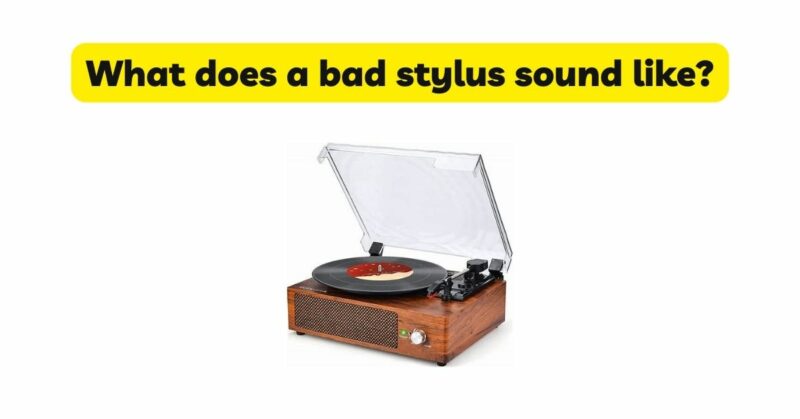Vinyl records have re-emerged as a beloved medium for music enthusiasts seeking an authentic and warm audio experience. However, the vinyl playback system is a delicate and intricate apparatus, heavily reliant on a well-maintained stylus to deliver the highest sound quality. A bad or worn-out stylus can significantly compromise the audio fidelity of vinyl records, leading to various sound issues and distortions. In this article, we will explore the implications of a bad stylus, identify common audio distortions, discuss their causes, and offer solutions to address these issues for an improved vinyl listening experience.
- The Role of the Stylus in Vinyl Playback
The stylus, also known as the needle, is a tiny but critical component of the vinyl playback system. Its role is to read the audio information stored in the grooves of the vinyl record. As the record spins, the stylus rides along the grooves, translating the physical changes in the groove’s shape into electrical signals. These signals are then amplified and reproduced as sound by the speakers.
The quality of the stylus is directly related to the accuracy with which it tracks the grooves. A well-maintained and properly aligned stylus ensures precise tracking, resulting in faithful audio reproduction. On the other hand, a bad stylus can lead to various sound distortions and deteriorate the overall listening experience.
- Identifying a Bad Stylus: Common Audio Distortions
A bad stylus can manifest in various audio distortions, indicating that it may be time for replacement or maintenance. Let’s explore some of the most common sound issues associated with a faulty stylus:
a. Distorted Sound: One of the most apparent signs of a bad stylus is distorted sound. This distortion may manifest as crackling, popping, or a muffled quality to the audio, indicating that the stylus is not correctly tracking the grooves.
b. Sibilance and Harshness: Sibilance refers to the exaggerated “s” and “sh” sounds in vocal recordings. A bad stylus can emphasize these frequencies, leading to a harsh and unpleasant listening experience.
c. Skipping and Jumping: If the stylus is unable to maintain proper contact with the grooves, it may result in skipping or jumping during playback. This issue can significantly disrupt the listening experience and potentially damage the vinyl record.
d. Surface Noise: A worn-out or damaged stylus can pick up more surface noise from the vinyl, such as static, clicks, and pops, detracting from the overall sound quality.
e. Lack of Clarity and Detail: A bad stylus may lead to a loss of clarity and detail in the audio, making it challenging to discern intricate elements of the music.
- Causes of Stylus Wear and Damage
Understanding the causes of stylus wear and damage is crucial for preventing audio distortions and preserving the longevity of both the stylus and vinyl records. Some common factors that contribute to stylus wear include:
a. Dust and Dirt: Dust and dirt particles can accumulate on the stylus, causing it to lose its precision and leading to sound distortions during playback.
b. Incorrect Alignment: If the stylus is not properly aligned with the grooves, it can place uneven pressure on the record, causing excessive wear on the stylus and the record itself.
c. Tracking Force: The tracking force, or the pressure applied by the stylus to the record, needs to be correctly adjusted. Too much or too little tracking force can cause stylus wear and audio distortions.
d. Frequency of Use: Regular usage of vinyl records can lead to stylus wear over time. The more frequently a stylus is used, the faster it will wear out.
- Solutions for Addressing a Bad Stylus
Thankfully, there are several solutions available to address a bad stylus and improve the sound quality of your vinyl records:
a. Stylus Replacement: If the stylus is worn-out or damaged, the most effective solution is to replace it. Consult the manufacturer’s guidelines or seek professional assistance to ensure you select the correct stylus for your cartridge.
b. Proper Cleaning: Regular cleaning of the stylus is crucial to prevent build-up of dust and dirt. Use a stylus brush or a specialized cleaning solution to carefully remove debris from the stylus tip.
c. Correct Alignment: Ensuring proper alignment of the stylus with the grooves is essential for reducing wear and maintaining optimal sound quality. Seek guidance from a professional or consult the turntable’s manual to align the stylus correctly.
d. Tracking Force Adjustment: Check the tracking force setting on your turntable and make necessary adjustments to ensure it falls within the recommended range for your stylus. This will help maintain proper stylus contact with the grooves and minimize wear.
e. Regular Maintenance: Develop a routine maintenance schedule for your turntable and stylus, including cleaning and inspection. This will help identify and address any potential issues before they escalate.
Conclusion
A bad stylus can significantly compromise the sound quality of vinyl records, resulting in audio distortions and an unsatisfactory listening experience. By understanding the common audio distortions associated with a faulty stylus, identifying the causes of stylus wear and damage, and implementing appropriate solutions, listeners can restore the accuracy and fidelity of their vinyl playback system. Regular maintenance, proper alignment, and stylus replacement when necessary are key to preserving the integrity of both the stylus and the vinyl records, ensuring an immersive and enjoyable vinyl listening experience.


